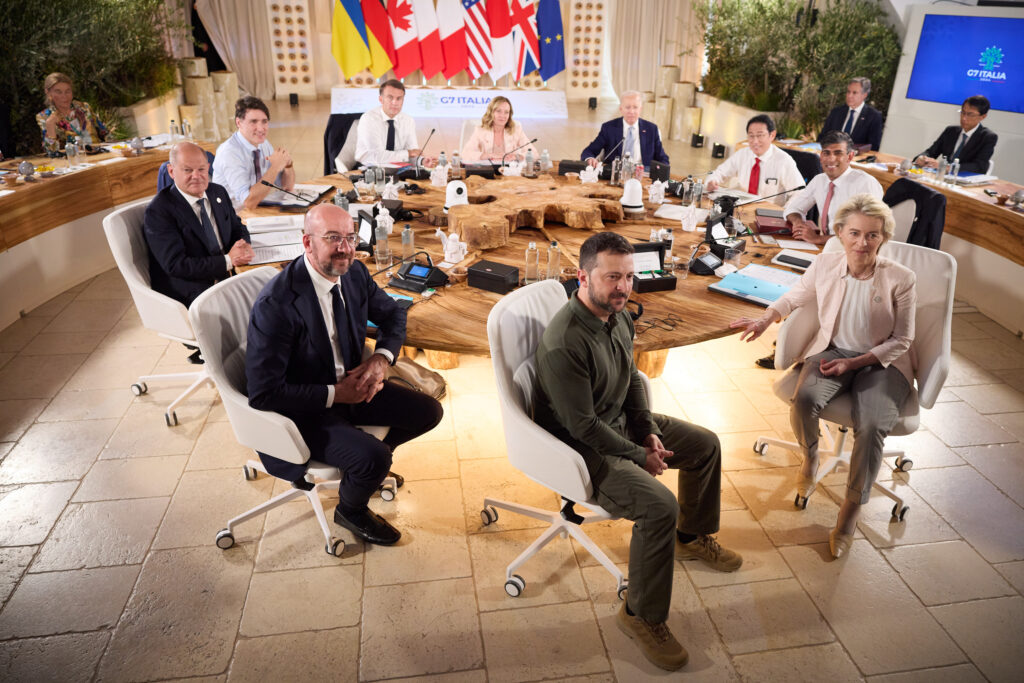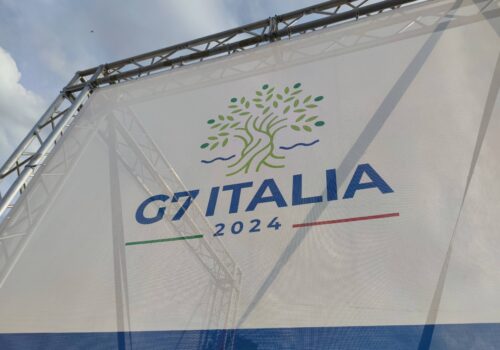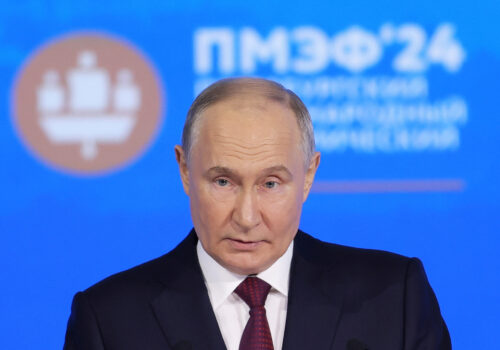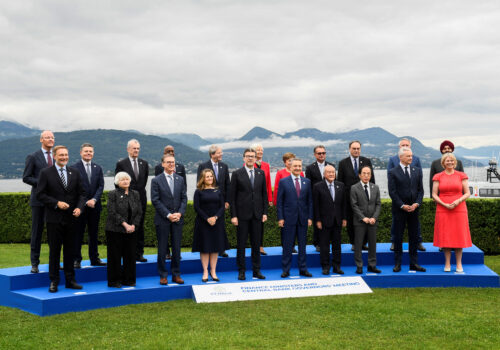Experts react: Ukraine gets $50 billion from Russian assets and a US security deal at the G7 summit
From Russia, with interest. The Group of Seven (G7) leaders announced Thursday that they had agreed on a plan to send fifty billion dollars to Ukraine in the coming months by pulling forward interest income on Russian assets that had been immobilized in Western countries since February 2022 (a novel idea that Atlantic Council research helped shape). Combined with the announcement of a bilateral security deal with the United States, Ukrainian President Volodymyr Zelenskyy took home significant wins from joining the summit of the world’s democratic economic heavyweights along Italy’s Adriatic coast. Below, our experts dig into the details on how these agreements came together and how they might reshape the conflict.
Click to jump to an expert analysis:
John Herbst: Putin’s bad late spring continues
Charles Lichfield: The beauty of compromise
Daniel Fried: After some wobbling, this was a week of solid Western backing for Ukraine
Rachel Rizzo: Amid G7 political uncertainty, Meloni is emerging as a bulwark of support for Ukraine
Ian Brzezinski: The US-Ukraine security deal can’t just be a bridge to indefinite NATO delay
Kimberly Donovan: New US sanctions are already impacting Russia—will China feel them too?
Putin’s bad late spring continues
Good news arrived from Italy today because of the superb work of the Biden administration. The G7 finally agreed to Deputy National Security Advisor Daleep Singh’s ingenious initiative to offer Ukraine this year a fifty-billion-dollar-low interest loan collateralized by frozen Russian state assets. US Treasury Secretary Janet Yellen’s strong intervention with reluctant G7 partners—France, Germany, Italy, and Japan—helped turn this initiative into G7 policy, which is critical for Ukraine as it fights intensifying Russian attacks on its energy infrastructure. This loan follows the renewal of US aid, the prompt dispatch of US war materiel to Ukraine after the renewal, the decision by the United States and several of its allies to permit Ukraine to use their weapons in Russia, and the subsequent halting of Moscow’s offensive in the north. In other words, Russian President Vladimir Putin’s bad late spring continues. This latest blow to the Kremlin underscores how important strong US leadership can be.
This leaves Putin’s coterie fulminating that it will strike back by expropriating Western assets in Russia. Maybe, but prudent firms—like France’s Total—have already written off investments in Russia; and if Russia wants to further mortgage its future by taking this step, it will make even more unlikely the return of foreign capital after its aggression in Ukraine flops and it tries to rejoin the community of nations. Put another way, Russia needs Western investment far more than Western investors need Russia. The havoc created in Russia’s financial markets by this week’s new US sanctions is just the latest indicator of who has the whip hand in the economic relationship between Russia and the West.
This tactical victory against Russian aggression is sweeter because it is also a defeat for Putin’s partner, Chinese leader Xi Jinping, who tried to bully the reluctant G7 members to deter them from embracing this policy. It might also provide a lesson to India, Saudi Arabia, Indonesia, and others who needlessly embarrassed themselves by supporting this failed Chinese effort.
While we should celebrate this day’s accomplishment, we must not rest on our laurels. The Biden administration should follow up its big win by building support for the initiative launched by Philip Zelikow, Lawrence Summers, and Robert Zoellick to seek the transfer of nearly all the roughly $300 billion in frozen Russian state assets to Ukraine.
—John E. Herbst is the senior director of the Atlantic Council’s Eurasia Center and a former US ambassador to Ukraine.
The beauty of compromise
The G7 has struck a deal on bringing forward the value of interest income made off Russia’s immobilized assets. Given that the group was acrimoniously divided over what to do as recently as February, this is an extraordinary achievement.
While it remains unclear exactly how, the United States will be involved. As one of the strongest supporters of the approach, Washington saw itself providing the biggest contribution to a sovereign loan of fifty billion dollars or more. But the European Union (EU) sanctions legislation, which keeps the bulk of the assets blocked, has to be renewed every six months, and the United States could not convince the twenty-seven member states of the EU to switch to a different approach. Reportedly, the United States will still now participate—though the full details of the plan have not yet been made public. Washington may use the five to eight billion dollars allegedly still in the United States to make a smaller loan, while the United Kingdom, Canada, and the EU make a bigger loan. Or perhaps the parties have agreed to keep working on a risk-sharing formula in case EU sanctions are lifted before the United States and other lenders have been paid back.
Fifty billion dollars is over half of Ukraine’s total expenditures in 2023—a game-changing amount. Still, supporters of confiscation are already calling today’s achievement “step one.” But we should appreciate how elegantly today’s compromise navigated the red lines of France, Germany, and other EU member states, while still providing a substantial amount. Let’s take the win and accept that confiscation remains off the table until a multilateral solution can be found.
—Charles Lichfield is the deputy director and C. Boyden Gray senior fellow of the Atlantic Council’s GeoEconomics Center.
After some wobbling, this was a week of solid Western backing for Ukraine
Western backing for Ukraine has firmed up in the wake of the miserably delayed vote for additional assistance by the US Congress in late April. On June 12, the United States issued its most effective sanctions against Russia in two years, a well-thought-out set of measures by the departments of Treasury, State, and Commerce that struck at Russia’s military industry; energy production; evasion of technology controls by firms in China, Turkey, the United Arab Emirates, and elsewhere; and more. One interesting measure was the expansion of authority for sanctions against non-Russian banks and other firms that support Russia’s military industry (“secondary sanctions” that European governments have loudly opposed but now seem to tacitly accept). It’s about time the United States took that step, and it needs to follow through, but it’s a welcome step all the same.
In another welcome move, the G7 has finally agreed (at least in principle) on an arrangement to use immobilized Russian sovereign assets, estimated at around $280 billion, to back Ukraine. In a swift and bold move days after the all-out Russian invasion of Ukraine in February 2022, the G7 locked down Russian assets but has ever since debated whether to use those funds to help Ukraine and, if so, how. Some argued for simply taking Russia’s money and having Russia pay directly for its war against Ukraine. But many in Europe resisted taking that step as too aggressive, even given Russia’s own aggressive war.
Extended European discussions produced a soft consensus to use the interest on the Russian assets. But that would generate only about three billion dollars per year, a sum not commensurate with Ukraine’s need. The United States came up with a creative (and complex) solution: Use twenty years’ or so worth of that interest to back funds to Ukraine, a scheme that could generate a sum of about fifty billion dollars. After much effort, the G7 has reached consensus on that plan. While details have yet to be worked out, fifty billion dollars is nothing to sneer at. The United States was right to close the deal on this compromise and also right in what seems to be its intention to use the principal, the full $280 billion.
In a third action, the United States and Ukraine have signed a bilateral memorandum of understanding (MOU) providing for ten years of security cooperation. This is the most recent of a series of bilateral MOUs between Ukraine and the countries supporting it in its fight for national survival. It’s not NATO membership, but the US and other security MOUs are arguably part of Ukraine’s “bridge to NATO,” as the Biden administration has put it.
Much depends on the battlefield, and the news is mixed: Ukraine seems to have halted the Russian ground offensive against Kharkiv, but the Russians could attack elsewhere. Russia is battering Ukraine’s energy infrastructure, but Ukraine has hit Russian military infrastructure in occupied Crimea and elsewhere. Still, it’s been a week of solid Western backing for Ukraine.
—Daniel Fried is the Weiser Family distinguished fellow at the Atlantic Council. His last position in the US government was as sanctions coordinator at the Department of State.
Amid G7 political uncertainty, Meloni is emerging as a bulwark of support for Ukraine
As leaders from the world’s G7 countries gather in Puglia, it’s hard to ignore a few big elephants in the room. First, French President Emmanuel Macron’s trouncing in the recent European Parliament elections by Marine Le Pen’s party led to his potentially politically fatal decision to dissolve parliament. Second, German Chancellor Olaf Scholz’s Social Democratic Party faced a similar result from the center-right Christian Democrats, and a map of Germany’s European Parliament voting results shows that the country is still clearly divided between east and west, with the former solidly in the Alternative for Germany (AfD) camp. Finally, US President Joe Biden arrived in Puglia after a months-long battle on Capitol Hill to pass the latest tranche of Ukraine aid and as the November election looms.
Who seems to be left out of all the political drama? Italian Prime Minister Giorgia Meloni, whose Brothers of Italy party took home a solid win in the European Parliament elections and who is taking the opportunity to bask in the limelight of transatlantic leadership. In fact, she said Italy is going into the summit with the “strongest government of them all.” She’s not wrong. It’s a surprising turn for Italy’s famously mercurial internal politics: Not only is she seen as a leader on the world stage, supporting Ukraine and NATO, but her leadership is also expected to hold through the entirety of her term. Meloni is using this moment to chart a new course for Italy, including by bringing leaders from outside the G7 to the summit, such as Narendra Modi of India, Cyril Ramaphosa of South Africa, and the pope for his first G7 appearance. She is also solidifying the country’s place at the center of a new relationship between the West and Africa, as well as supporting the EU’s plan to provide a fifty-billion-dollar lifeline to Ukraine using frozen Russian assets.
Not only is this good for Meloni, but having a bulwark of support amid uncertain political futures in much of the West is good for Ukraine, too.
—Rachel Rizzo is a nonresident senior fellow with the Atlantic Council’s Europe Center.
The US-Ukraine security deal can’t just be a bridge to indefinite NATO delay
The just-announced US-Ukraine security agreement has much good in it, if the US government chooses to execute it in a manner that enables Ukraine to defeat Russia’s invasion quickly, decisively, and on Kyiv’s terms.
However, the language presenting “a bridge to Ukraine’s eventual membership in the NATO alliance” is yet another repeat of the Alliance’s sixteen-year-old assertion that membership is not a matter of if but when—this time backed by extensive inferences that Ukraine is far from ready for NATO membership.
Nothing is further from the truth. Ukraine meets all the requirements spelled out in Article 10 of the Washington Treaty. It’s a European state. Its democratic credentials are codified in repeated elections found to be free and fair—even when subjected to Russian interference. No country has sacrificed more blood in the defense of transatlantic security in NATO’s history.
That Ukraine would sign up to such language reflects its own disillusionment in the face of US resistance to its aspirations for NATO membership—a disillusionment that was reinforced by Biden’s recent assertion to TIME that peace in Europe does not require Ukrainian membership in NATO.
To reverse this disillusionment and convince Ukraine that this bridge to NATO is not a route to indefinite delay, the Alliance must take tangible steps to integrate Ukraine into its operations and decision making. For too long, Ukraine has remained an outsider to the Alliance amid empty promises of eventual inclusion.
Ukraine should be invited to assign personnel to NATO headquarters and command structures and to sit as an observer at the North Atlantic Council, the Alliance’s top decision-making body. The latter privilege was afforded to countries such as Sweden and Finland, after they were invited to join NATO but before they became members. While that privilege gave those allies a voice in NATO deliberations, it came with no vote and no veto in Alliance decisions and no Article 5 security guarantee.
Ukraine has much to add to the Alliance in those capacities. No country has more experience and expertise to share when it comes to fighting Russia.
These proposals would resonate powerfully in Ukraine and would receive broad support across the Alliance. Even if there is resistance, just by pressing them forward, the United States, as the leader of NATO, would significantly bolster the credibility of its—and the Alliance’s—promise to fulfill Ukraine’s well-deserved transatlantic aspirations.
—Ian Brzezinski is a senior fellow at the Atlantic Council and a former US deputy assistant secretary of defense for Europe and NATO policy.
New US sanctions are already impacting Russia—will China feel them too?
The US Treasury’s latest round of sanctions targeted critical aspects of Russia’s financial infrastructure, including the Moscow Exchange (MOEX) and National Clearing Center, among others. These new sanctions are already having an effect. The Central Bank of Russia and MOEX halted trading in US dollars and euros in response to the announcement.
Treasury’s announcement also came with an expansion of secondary sanctions. The secondary sanctions authority that was announced in December was specific to Russia’s military industrial base. The expanded definition of secondary sanctions now includes any Russian individual and entity designated pursuant to Executive Order 14024, which accounts for most of the US Russia-related sanctions. This means that banks that are still transacting with Russia in places such as China and India are exposed to the risk of secondary sanctions. It will be interesting to see how China, and specifically Chinese financial institutions, respond to the latest US actions, considering how Russia has become economically and financially reliant on China over the past two years.
Further, Treasury clarified that the foreign branches of designated Russian banks, such as VTB in China and India, are sanctioned and added their entity names and addresses to the Specially Designated Nationals list. We called out this sanctions gap in the latest edition of the Russian Sanctions Database that we published in May. This action should restrict how Chinese companies do business with Russia, but we’ll have to see, as much of the transactions occur in renminbi, not US dollars.
—Kimberly Donovan is the director of the Economic Statecraft Initiative within the Atlantic Council’s GeoEconomics Center and a former senior official with the US Treasury Department’s Financial Crimes Enforcement Network.
Further reading
Wed, Jun 12, 2024
Seven charts that will define the G7 summit
New Atlanticist By Atlantic Council GeoEconomics Center experts
These charts illustrate the essential economic data that will drive G7 leaders’ decisions when they meet in Italy from June 13 to 15.
Tue, Jun 11, 2024
Seven ways to reboot G7 sanctions on Russia
New Atlanticist By Daniel Fried
Russia is adapting to Western sanctions, but there are viable options to intensify the economic hit on its economy for its brutal war on Ukraine.
Sat, May 25, 2024
Experts react: What to know about the latest G7 ‘progress’ on using blocked Russian assets to aid Ukraine
New Atlanticist By Atlantic Council experts
Group of Seven (G7) finance ministers just met in Stresa, Italy, to discuss what to do with blocked Russian assets. Atlantic Council experts follow the money.
Image: Ukraine President Volodymyr Zelenskyy meets leaders of the Group of Seven (G7) leaders’ summit meeting at Borgo Egnazia in Fasano, Puglia, Italy on June 13, 2024.




